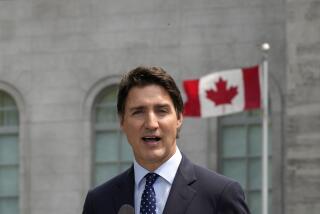There are two sides to strong Canadian dollar
- Share via
TORONTO — When Canada’s dollar reached parity with the American currency last week -- for the first time in 31 years -- the nation erupted in a very un-Canadian bout of chest-thumping.
Television crews aired footage of gloating citizens cheering the “fantastic news.” Newspapers ran headlines such as “Canadians getting ‘richer’ ” and “The loonie soars; the eagle falls.” Some shoppers headed south of the border to treat themselves to bargains.
The Canadian loonie -- the nickname comes from the bird on the face of the country’s dollar coin -- had long been worth so much less than the U.S. dollar that it had earned the nickname the “northern peso.” In 2002, a Canadian dollar was worth 62 cents in the U.S.
But amid the recent bravado were stark reminders that the appreciation of the Canadian currency wasn’t good news for everyone here -- particularly manufacturers, those in the tourism business and the Canadian film and television industry. A rising Canadian dollar makes Canadian goods more expensive for Americans.
“The personal sentiment really depends on what you’re working in,” said Craig Alexander, an economist with TD Bank in Toronto. “Manufacturing and tourism are feeling a big negative impact, as [is] anybody who depends on the U.S. Hundreds of thousands of jobs have been lost, and they’re probably not feeling too happy.”
In Toronto, the hub of the nation’s film and television industry, overall production spending was 700 million Canadian dollars last year, a drop from a high of 1 billion in 2000. The industry has blamed the slide on the competitive tax incentives of other jurisdictions as well as the soaring currency.
In the province of Ontario, foreign production -- mostly from the U.S. -- declined by 30% in the last two years alone, to $338.7 million Canadian from $486.3 million.
“The dollar is a big issue right now,” said John Weber, president of Dufferin Gate Productions, a services company that caters to many U.S. productions. “Hollywood is looking at other places to shoot. Where they used to go straight to Canada, because of the Canadian dollar, they’re now looking elsewhere.”
At the moment, many in the Toronto industry say American production spending in Canada has remained similar to last year’s levels because major studios have ramped up production to stockpile material in anticipation of potential strikes by the Screen Actors Guild and the Writers Guild. But insiders say that after the current run of U.S. production is finished, the Canadian industry could go quiet for a while.
“We’re busy until June” 2008, said Ken Ferguson, president of Toronto Film Studios, the largest studio operator in the city. “The major Hollywood studios are ignoring market conditions right now, but we’ll see what happens next year. Hopefully, the Canadian dollar will have come down by then.”
Despite the slowdown in film activity in Canada, Hollywood unions remain concerned about runaway production north of the border.
The Screen Actors Guild, the Teamsters and several unions representing Hollywood’s technical workers recently filed a petition with the U.S. trade representative alleging that Canadian government subsidies that target U.S. film and TV productions constitute unfair trade practices and violate Canada’s obligations under World Trade Organization rules.
The Canadian dollar has risen 16% against the greenback just in the last nine months. Part of the reason is economic weakness in the U.S. (the dollar is down against many currencies), and part is Canada’s booming exports of commodities including natural gas, gold and oil, the price of which has lately been at a record high.
Samantha McWilliams, a 30-year-old Toronto lawyer, drove to upstate New York with her brother last weekend to take advantage of the reversal of fortune.
Her brother went full tilt, spending more than $700 on a new wardrobe, while she watched. The cause for her restraint: She had spent about half that on a similar U.S. shopping trip earlier in the summer.
“It’s incredible,” McWilliams said. “We went on Monday, just after the loonie hit parity, and you could see that some stores were clearly out of things. The Canadians went through it all.”
The shopping spree isn’t only in the border towns. U.S. online retailers also are noticing a jump in Canadian sales. According to Canada Post, the volume of shipments from U.S. retailers rose 38% last year, and economists expect that number to increase even more dramatically during the Christmas shopping season.
The cross-border spree is amplified by the fact that Canadian retailers haven’t adjusted their prices of imported goods to reflect the rising Canadian dollar. A 4-gigabyte iPod, for example, costs $149 on Amazon.com but is listed for $169.99 Canadian on www.futureshop.ca, which is run by a Canadian electronics chain. The difference in prices is more acute for luxury goods. A study by DesRosiers Automotive Consultants showed that the average luxury sports car was $13,694 more expensive in Canada.
Canadian retailers are certain to feel the pinch from the rush across the border, but some economists in Canada wonder whether the euphoria about the increased spending power of the higher dollar is overblown. Practical considerations such as transportation and taxes still stand in the way.
“Somebody was saying to me the other day that there’s huge savings to be had if you want to buy household appliances in the U.S.,” said Alexander, the economist. “But who is going to rent a van just to drive a fridge across the border? Is it really worth the hassle?”
More to Read
Sign up for Essential California
The most important California stories and recommendations in your inbox every morning.
You may occasionally receive promotional content from the Los Angeles Times.










